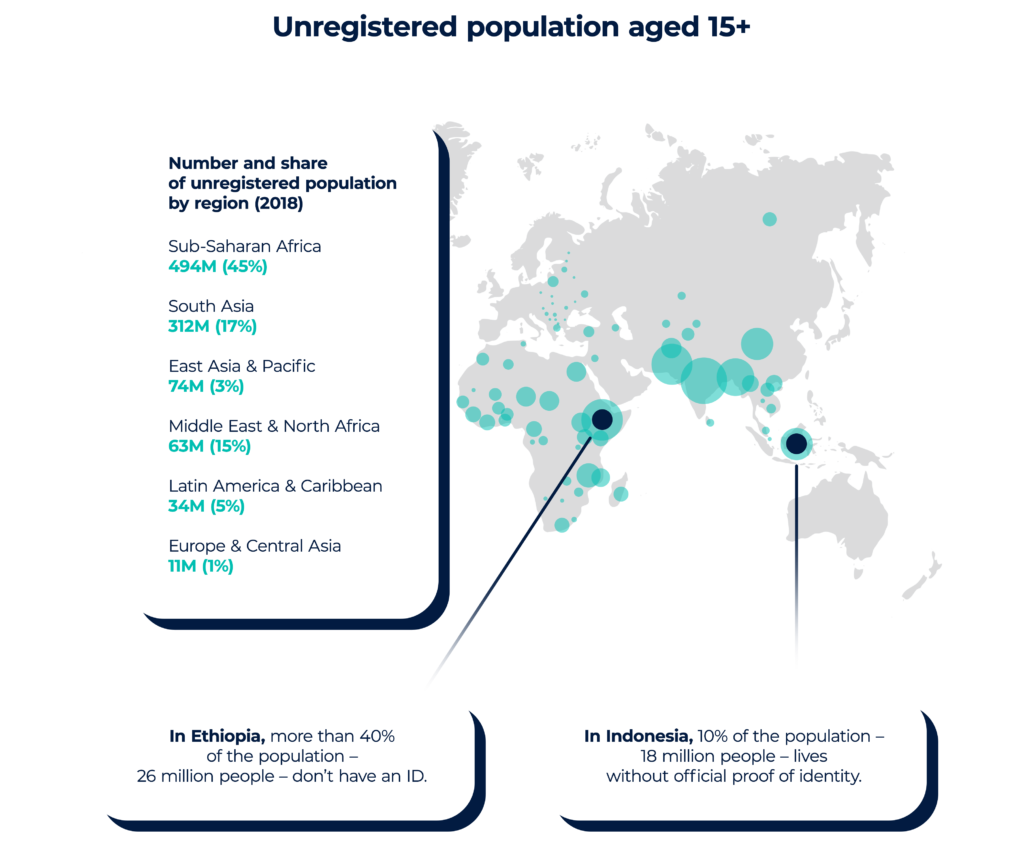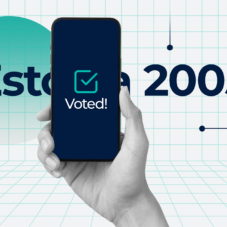From Indonesia to Germany: why so many democracies don’t have fair elections

Inequality in elections has plagued democracies around the globe, not only in lower-income countries but also in developed nations such as the US or Germany.
Often, the biggest sign of an unfair election is low voter turnout: the fewer people that show up to vote, the greater the social and economical inequalities in the country. But shouldn’t democracy ensure that every eligible citizen is able to cast their vote?
In 2019, nearly two billion voters in 50 countries around the world were to express their views on their country’s presidents, governments and politicians. Among those countries were some of the world’s largest democracies – including India, Indonesia and Nigeria – yet even so, not every one of their citizens was able to register to vote.
One billion people cannot prove who they are
It is estimated that one billion people around the world lack official proof of identity, which is critical to register to vote. Of these one billion people, more than 80% live in Sub-Saharan Africa and South Asia. For example, in Chad in Central Africa, more than 60% of people aged over 15 don’t have proof of identification, while in Indonesia it is almost 10%.
These people are often part of the most marginalised groups. Not being able to prove who you are means that you have only limited access (or none at all) to vital services, so participation in voting and economic life can be very confined. Women are particularly affected – in low-income countries, one in every two women does not have an ID.

In Nigeria, only about 20% of the national population has been registered in Nigeria’s foundational ID system. The main reason behind this is a fragmented ID ecosystem containing a variety of other functional ID schemes, such as a driver’s licence or bank verification number, all of which leads to confusion and enrolment fatigue.
“Women are particularly affected – in low-income countries, one in every two women does not have an ID.”
Countries all over the world are turning to biometrics to provide reliable citizen identification and create a trusted civil registry. Innovatrics’ ABIS solution for Civil Identification contains predefined modules for enrolment, matching, and searches, making it easy to deploy solutions for:
- National ID, Driver’s Licence and Passport Issuance
- Border Control
- Visa Issuance
- Identity Management for Elections
- Social Security, Pension and Health Care
- Ghost Worker Detection System
Furthermore, only 41% of the registered Nigerian population are women. There are multiple reasons why this is so, but one of the most prevalent is social norms about gender roles – which often lead to a lack of knowledge and awareness, or the need for women to get permission from their husbands and fathers in order to register.
Ethnic voter suppression in India
In 2019, India had to deal with some serious allegations of voter suppression: a strategy used to prevent certain groups of people from voting in an effort to influence the outcome of elections.
In the national election of May 2019, nearly 900 million citizens were eligible to vote, or so they thought. Around 120 million people who went to cast a ballot learned the hard way that their names had been struck off the voter register. In the past they had all voted without problems, and had done nothing to warrant being stripped of their right to vote.
More than half of those disenfranchised citizens were from minorities that amount to almost a third of the country’s population. Since most people only learned about this problem on election day, it was too late to fix it.
When probed, authorities provided almost zero helpful answers – but some explanations gradually appeared. It turns out it’s not that hard to remove someone’s name from the voter roll, you just need to visit a website and fill out a form. Based on an investigation by Al Jazeera, if a person knows which polling booth someone is registered at, they can simply say that person doesn’t live in the area and ask for their removal.
It is believed that people with names typical to lower income groups or ethnic groups were victims of this scheme, being purposefully removed because of the assumption that they wouldn’t vote for the governing party. Hence the allegations of voter suppression.
“It is believed that people with names typical to lower income groups or ethnic groups were victims of this scheme, being purposefully removed because of the assumption that they wouldn’t vote for the governing party.”
More than 120 million citizens being disenfranchised has the clear potential (or indeed, probability) to swing an election result. Upon analysing the 2019 elections, political scientists also found approximately 28 million women to be missing from the electoral roll, which averages 38,000 per constituency – a number often higher than the winning margin in many lower-house electoral contests.
The higher the voter turnout the fairer the elections
The sign of a functioning democracy is a high voter turnout. But even in developed countries such as the United States, millions of people that are eligible to vote face barriers in elections.
According to MIT, in 2020 the number of eligible voters in the United States was estimated at almost 240 million people. And even though 71% of white voters cast ballots, the voter turnout of non-white voters didn’t surpass 58%.
There are various explanations for this. One that automatically comes to mind is that some citizens just don’t want to participate in the election. However, not voting by choice in the US is attributed primarily to white citizens, while the majority of minorities face systemic obstacles along the way.
Barriers standing in the way of equality
In the US, African-American and Latino voters are at twice the risk of being poor compared to White Americans. Material deprivation and bad health both limit participation in voting. Income inequality is therefore correlated with the lack of participation in elections, nurtured by the decades-long unequal economic system.
Yet there are more factors at play, too. Elections usually take place during a working day, meaning that working members of a minority in the States would need to take time off work to stand in line – and usually for a much longer time than workers in white and wealthy neighbourhoods, due to a tendency to establish fewer voting centres in less affluent neighbourhoods.
The need to travel to polling stations far away can also be an important barrier, especially for older people or those with disabilities. In some rural areas, citizens need to travel long distances to the nearest centre. In rural parts of Texas, for example, the journey can be as long as 170 miles (273.5 km).

The fact that poor people in developed democracies are less inclined to vote, or face more complications to do so, is not just a problem in the United States. In 2021, the German Bundestag elections predicted low voter turnout in poorer places, such as Duisburg-Hochfeld. The source of such predictions was a study from 2010, which concluded that the areas in which voter turnout is low have twice as many single mothers as in other districts, and four times the unemployment rate.
“A study concluded that the areas in which voter turnout is low have twice as many single mothers as in other districts, and four times the unemployment rate.“
In the 11 years since this study was published, the situation in many of those places – including Duisburg-Hochfeld – has only become worse: social inequality has increased, and those who feel socially marginalised usually don’t trust the ballot box to change anything.
A gun license is as good as an ID
Many countries around the world register their voters automatically after they reach the age of 18. However, in the United States, unless you live in North Dakota, you need to register to vote.
There is no official “national identity card” in the US. The majority of states therefore have their own strict identification requirements at the polling stations, such as a government-issued photo ID. However, numerous studies have found that a significant number of votes are lost due to registration problems, simply because people don’t have the right ID. The problem is that not every American has the right form of identification accepted for voting. Millions don’t have an ID, and it was estimated that a quarter of all African-American citizens who are of voting age don’t have a government-issued photo ID. In comparison, for the white population, that rate is only 8%.
“In Texas, citizens can use gun licenses to vote, but not student IDs. More than 80% of handgun licenses go to white Texans, while more than half of the students in the University of Texas system are from ethnic minorities – which leads to a highly unbalanced voter register.”
Texas is a particularly interesting example, as citizens there can use gun licenses to vote, but not student IDs. “More than 80% of handgun licenses go to white Texans, while more than half of the students in the University of Texas system are from ethnic minorities – which leads to a highly unbalanced voter register,” claims the Brennan Centre for Justice. Texas passed this voter ID law in 2013, just two hours after the US Supreme Court dismissed the need for federal approval before changing voting laws.
Worldwide, eligible voters who do not participate in elections are generally disproportionately poor, have minority ethnic and racial backgrounds, or are older persons, ill or with disabilities. Therefore, according to critics, the majority of democratic electoral systems are believed to be unequal and discriminatory.
To break out of this vicious cycle, policymakers should reform their respective country’s voting systems in a way that will fully represent the country’s economic, social and racial diversity. Meanwhile, citizens should never stop advocating for their right to vote and participate in public affairs. Equality and other principles of democracy cannot be taken for granted or left unprotected – they have to be fought for and nurtured.
AUTHOR
Nikola Šulíková Bajánová
PHOTOS
Shutterstock
SOURCES
US Elections Project
Inequality Keeps People from Voting
Poor and Minorities Less Likely to Vote
Why Many Americans Don’t Vote
Voter Turnout Trends
The New Voter Suppression
Voter ID 101
ID4D
Global Identification Challenge
The global identification challenge
Understanding the gender gap in ID
Barriers to the inclusion of women
Germany’s poor don’t vote
Allegations of voter exclusion India









